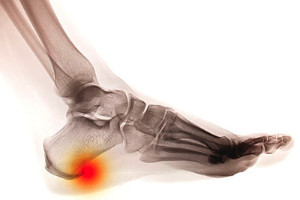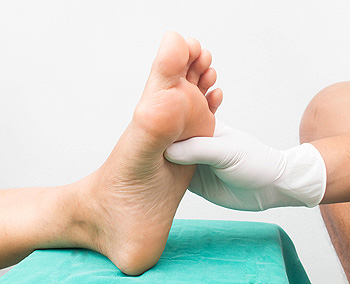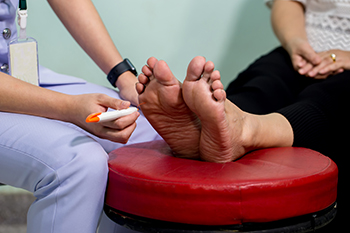Connect With Us
Blog
Items filtered by date: December 2023
Gentle Exercises That May Help Heel Spurs

Heel spurs are bony outgrowths at the base of the heel bone, and implementing targeted exercises is a proactive approach to managing heel spur pain. Stretching exercises, such as towel curls and toe stretches, help maintain flexibility in the foot's connective tissues, mitigating strain on the heel. Calf stretches, performed against a wall, alleviate tension in the Achilles tendon, and may help to reduce the impact on the heel spur. Rolling a frozen water bottle under the foot not only provides relief but also minimizes inflammation. Incorporating these exercises into a regular routine can contribute to the gradual alleviation of heel spur discomfort. It is imperative to approach these exercises with patience, allowing the body time to adapt and heal. Consultation with a podiatrist is advisable to tailor exercises to individual needs. If you have developed a heel spur, it is suggested that you schedule an appointment with a podiatrist who can effectively diagnose and treat this condition.
Heel spurs can be incredibly painful and sometimes may make you unable to participate in physical activities. To get medical care for your heel spurs, contact Kevin Powers, DPM from The Center for Lower Extremity Nerve Surgery. Our doctor will do everything possible to treat your condition.
Heels Spurs
Heel spurs are formed by calcium deposits on the back of the foot where the heel is. This can also be caused by small fragments of bone breaking off one section of the foot, attaching onto the back of the foot. Heel spurs can also be bone growth on the back of the foot and may grow in the direction of the arch of the foot.
Older individuals usually suffer from heel spurs and pain sometimes intensifies with age. One of the main condition's spurs are related to is plantar fasciitis.
Pain
The pain associated with spurs is often because of weight placed on the feet. When someone is walking, their entire weight is concentrated on the feet. Bone spurs then have the tendency to affect other bones and tissues around the foot. As the pain continues, the feet will become tender and sensitive over time.
Treatments
There are many ways to treat heel spurs. If one is suffering from heel spurs in conjunction with pain, there are several methods for healing. Medication, surgery, and herbal care are some options.
If you have any questions feel free to contact our offices located in Indianapolis and Bloomington, IN . We offer the latest in diagnostic and treatment technology to meet your needs.
Heel Pain in the Morning?
Runners and Plantar Fasciitis

Running enthusiasts often face the challenge of foot and ankle injuries, with plantar fasciitis being a common adversary, constituting approximately 25% of running-related issues. This condition involves inflammation of the thick band of tissue, the plantar fascia, connecting the heel bone to the toes. To mitigate the risk of plantar fasciitis and other foot and ankle injuries, careful consideration of footwear is essential. Choose running shoes with proper arch support and cushioning, as inadequate footwear contributes significantly to plantar fasciitis. Regularly replacing shoes is also needed to maintain their effectiveness. Further, gradual progression in running intensity or distance is vital, as abrupt increases can strain the plantar fascia and lead to injury. Incorporating a pre-run stretching routine targeting the calves, Achilles tendon, and plantar fascia enhances flexibility, reducing the likelihood of injuries. Equally important is a focus on foot strengthening exercises, such as toe curls and resistance band exercises, which contribute to better support and reduce the overall risk of foot and ankle issues. By understanding and addressing these factors, runners can take proactive steps to keep their feet pain-free, ensuring a sustained and enjoyable running experience. If persistent discomfort arises, it is suggested that you schedule an appointment with a podiatrist for personalized guidance on managing plantar fasciitis.
Plantar fasciitis can be very painful and inconvenient. If you are experiencing heel pain or symptoms of plantar fasciitis, contact Kevin Powers, DPM from The Center for Lower Extremity Nerve Surgery. Our doctor can provide the care you need to keep you pain-free and on your feet.
What Is Plantar Fasciitis?
Plantar fasciitis is the inflammation of the thick band of tissue that runs along the bottom of your foot, known as the plantar fascia, and causes mild to severe heel pain.
What Causes Plantar Fasciitis?
- Excessive running
- Non-supportive shoes
- Overpronation
- Repeated stretching and tearing of the plantar fascia
How Can It Be Treated?
- Conservative measures – anti-inflammatories, ice packs, stretching exercises, physical therapy, orthotic devices
- Shockwave therapy – sound waves are sent to the affected area to facilitate healing and are usually used for chronic cases of plantar fasciitis
- Surgery – usually only used as a last resort when all else fails. The plantar fascia can be surgically detached from the heel
While very treatable, plantar fasciitis is definitely not something that should be ignored. Especially in severe cases, speaking to your doctor right away is highly recommended to avoid complications and severe heel pain. Your podiatrist can work with you to provide the appropriate treatment options tailored to your condition.
If you have any questions please feel free to contact our offices located in Indianapolis and Bloomington, IN . We offer the newest diagnostic and treatment technologies for all your foot and ankle needs.
Managing Charcot-Tooth-Marie Disorder

Charcot-Marie-Tooth disorder, or CMT, is an inherited neurological disorder that affects individuals globally. CMT is characterized by a gradual degeneration of muscles in the foot, lower leg, hand, and forearm, accompanied by a mild loss of sensation in limbs, fingers, and toes. The initial signs of Charcot-Marie-Tooth disorder are often a high-arched foot or difficulties in walking. Additional symptoms can include foot bone abnormalities like hammer toes, challenges with balance, occasional muscle cramping in lower legs, and loss of reflexes. While there is currently no cure for CMT, proper foot care, including wearing custom-made shoes and leg braces, can alleviate discomfort and help retain function. Moderate activity are often recommended to maintain muscle strength, with adaptive devices or surgery considered based on medical indications. Most individuals can continue to work, and wheelchair confinement is rare. For help in managing Charcot-Marie-Tooth disorder, it is suggested that you schedule an appointment with a podiatrist.
Some foot conditions may require additional professional care. If you have any concerns, contact Kevin Powers, DPM of The Center for Lower Extremity Nerve Surgery. Our doctor can provide the care you need to keep you pain-free and on your feet.
Rare Foot Conditions
The majority of foot conditions are common and can be treated by a podiatrist. Standard diagnostic procedures are generally used to identify specific conditions and treatment can be rendered. A podiatrist also treats rare foot conditions which can be difficult to diagnose and may need extra attention and care.
There are many rare foot conditions that can affect children. Some of these can include:
- Freiberg’s disease
- Kohler’s disease
- Maffucci syndrome
Freiberg’s disease - This can be seen as a deterioration and flattening of a metatarsal bone that exists in the ball of the foot. It typically affects pre-teen and teenage girls, but can affect anyone at any age. Symptoms that can accompany this can be swelling, stiffness, and the patient may limp.
Kohler’s disease - This often targets the bone in the arch of the foot and affects younger boys. It can lead to an interruption of the blood supply which ultimately can lead to bone deterioration. The patient may limp or experience tenderness, swelling, and redness.
Maffucci syndrome - This affects the long bones in a child’s foot leading to the development of abnormal bone lesions. They are benign growths and typically develop in early childhood and the bones may be susceptible to breaking.
A podiatrist can properly diagnose and treat all types of rare foot conditions. If your child is affected by any of these symptoms or conditions, please don’t hesitate to call our office so the correct treatment method can begin.
If you have any questions please feel free to contact our offices located in Indianapolis and Bloomington, IN . We offer the newest diagnostic tools and technology to treat your foot and ankle needs.
Daily Foot Care Tips for Diabetic Patients

If you have diabetes, prioritizing your foot care plays an essential part in preventing serious complications. A diabetic foot care routine begins by inspecting your feet daily for any signs of trouble such as cuts, redness, swelling, sores, blisters, corns, or calluses. Wash your feet daily in warm water, using a mild soap. Ensure thorough drying, especially between the toes, to prevent moisture related issues. Avoid walking barefoot, even inside your home, to protect your feet from potential injuries and infections. Choose shoes that fit well and provide proper support and protection. Always wear socks to reduce friction and to help in keeping your feet dry. When it comes to toenail care, trim them straight across and smooth out sharp edges with a nail file. Avoid cutting too close to the skin to prevent ingrown toenails. Seek professional help for the removal of corns or calluses, as attempting to do it yourself may lead to complications. Incorporating these simple, yet effective, practices into your daily routine can significantly reduce the risk of foot complications associated with diabetes. Periodic monitoring from a podiatrist is essential to avoiding problems such as foot ulcers. If you have diabetes, regular visits to a podiatrists are recommended.
Diabetic foot care is important in preventing foot ailments such as ulcers. If you are suffering from diabetes or have any other concerns about your feet, contact Kevin Powers, DPM from The Center for Lower Extremity Nerve Surgery. Our doctor can provide the care you need to keep you pain-free and on your feet.
Diabetic Foot Care
Diabetes affects millions of people every year. The condition can damage blood vessels in many parts of the body, especially the feet. Because of this, taking care of your feet is essential if you have diabetes, and having a podiatrist help monitor your foot health is highly recommended.
The Importance of Caring for Your Feet
- Routinely inspect your feet for bruises or sores.
- Wear socks that fit your feet comfortably.
- Wear comfortable shoes that provide adequate support.
Patients with diabetes should have their doctor monitor their blood levels, as blood sugar levels play such a huge role in diabetic care. Monitoring these levels on a regular basis is highly advised.
It is always best to inform your healthcare professional of any concerns you may have regarding your feet, especially for diabetic patients. Early treatment and routine foot examinations are keys to maintaining proper health, especially because severe complications can arise if proper treatment is not applied.
If you have any questions please feel free to contact our offices located in Indianapolis and Bloomington, IN . We offer the newest diagnostic and treatment technologies for all your foot and ankle needs.

